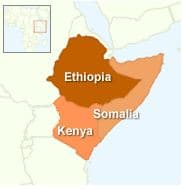 As you’ve no doubt seen in the news, East Africa is experiencing the worst drought in 60 years, with more than 10 million people threatened by starvation in four countries – Somalia, Ethiopia, Kenya and Djibouti. Somalia is hardest hit, with the UN declaring a famine in some regions. At least six out of 10,000 children are dying every day in Somalia, the UN says. (Read more about the causes of famine and how it can be prevented.)
As you’ve no doubt seen in the news, East Africa is experiencing the worst drought in 60 years, with more than 10 million people threatened by starvation in four countries – Somalia, Ethiopia, Kenya and Djibouti. Somalia is hardest hit, with the UN declaring a famine in some regions. At least six out of 10,000 children are dying every day in Somalia, the UN says. (Read more about the causes of famine and how it can be prevented.)
International relief agency Oxfam is responding to the hunger crisis, aiming to provide aid to approximately three million people across the region.
According to Oxfam.org, drought is worsening across the Horn of Africa, following successive failed rains. The late 2010 rainy season failed completely in many parts of Somalia, Ethiopia and Kenya, and now the April-May rains have also performed well below average. Parts of northeast Kenya have received just 10% of the usual level of rainfall.
The price of staple foods has risen to unaffordable levels for many people, and weak animals and the collapse of livestock markets have reduced people’s income and ability to buy essentials. Hundreds of thousands of animals – people’s main assets – have reportedly died.
Oxfam’s response:
Oxfam’s response to the drought includes programs in Somaliland, Ethiopia and Kenya with a mixture of emergency aid, long-term development and prevention, and advocacy to address the root causes of chronic drought.
Ethiopia
3.2 million Ethiopians are affected by the crisis – and over 2 million of them are in the Somali region in the southeast of the country, where Oxfam is responding and assisting about 150,000 people while scaling up the response in an effort to reach 700,000 people.
Oxfam is helping communities look for more sustainable sources of water by drilling boreholes, developing motorized water schemes and improving traditional water harvesting systems. In the driest and worst affected areas Oxfam has been trucking in emergency water supplies to over 32,000 people. The water is treated and used for drinking, cooking, washing and keeping animals alive. Each person gets at least 5 liters of water per day – the bare minimum that people need. Community health workers also conduct public campaigns to help stop the spread of water-borne diseases such as diarrhea.
Kenya
2.4 million Kenyans are affected by the crisis – mainly in the southern agricultural areas and the northern pastoralist regions, such as Turkana and Wajir where Oxfam is working.
People in these areas rely on their livestock as their main source of income and nutrition, but the drought has left the animals weak, dying and hard to sell. Oxfam’s “de-stocking” program buys up some of the weakest goats and, sheep – ensuring that their owners get an income and some vital cash before their assets die – and Oxfam then slaughters the animals to provide meat to the community.
About 900,000 vulnerable animals – belonging to 18,000 families – are also benefiting from Oxfam’s veterinarian and de-worming programs.
Somalia
2.4 million people are currently affected as the drought worsens across Somalia and Somaliland. In the worst hit areas of Somaliland, Oxfam and its local partners are providing emergency water trucks, bringing clean water to villages where all other sources have dried up. 65,000 people in more than 50 villages are benefiting, and this is the only way they can get water free of charge. Oxfam engineers also repair boreholes and shallow wells in areas where there is some available water.
Donate:
Please consider helping fund the emergency work of Oxfam in East Africa. You can donate directly to Oxfam America here.
To view a special report on the crisis direct from Kenya, check out this Oxfam video on YouTube.
Note: Oxfam America is a client of For Momentum.

